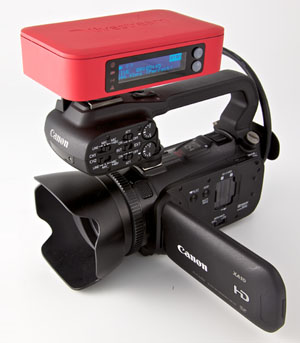Livestream: No Computer Required
While most live streaming service providers offer software encoders that integrate tightly with their service, Livestream is the first to offer a standalone H.264 hardware encoder that operates without a computer connection and can transmit via 3G/4G or via ethernet or Wi-Fi connections. The device, called Livestream Broadcaster, costs $495, including 3 free months of service on the New Livestream Platform.
In operation, Broadcaster accepts HDMI video input (1080i/720p/480i) as well as line-in audio. As Livestream points out in the product FAQ, if your camera doesn’t output HDMI, you can use converters like the BlackMagic Design HD-SDI to HDMI converter to produce the required HDMI signal.
On the output side, Broadcaster can transmit over a traditional Ethernet connection, over Wi-Fi, or via 3G/4G modems that connect via USB. The unit comes with a power supply but can also be battery operated, and it has screws on the bottom for mounting to a tripod connector.
Broadcaster can’t be used as a hardware encoder controlled by a local computer via USB; operation is totally standalone. The unit can be driven via the joystick and action buttons on the front panel, but once it’s online, you can control operation from Livestream.com or via a free iPhone application. You can choose between four data rates (Mobile, Normal, Medium, High and HD 720p) with the highest data rate at 2.3Mbps.
Broadcaster will be hard-coded into the new Livestream system and can’t be used for other streaming services or CDN, or even the original Livestream service. The unit is scheduled to ship by May 31 and comes with a 12-month limited warranty.
 Beyond the Speeds and Feeds
Beyond the Speeds and Feeds
These product details are simple enough; how Broadcaster fits into Livestream’s product offering in the short and long term takes some explanation. I got a chance to talk with Livestream CEO Max Haot about these issues, and here’s what we discussed.
First, as part of the announcement, Livestream reiterated pricing details on the New Livestream service, which is $45/month for unlimited streaming and storage. I was curious as to how this relates to pricing for their existing service, which starts at $350/month with storage and streaming limitations, and can go much higher.
Haot explained that the $45/month is for the new service, not the old, and that existing customers will continue on their current plans until they migrate to the new service. He explained that the new service, recently out of beta, doesn’t have all of the features of the original service, and more significantly, doesn’t offer embedding yet, just viewing on the Livestream platform.
While eventually the feature set of the new platform will equal the old, and embedding will be introduced, it’s not there yet, so most existing customers won’t want to transition over immediately. Haot also noted that there was no free option on the newer plan, just the $45/month, which he says will help “democratize” live streaming. He expects that a free, advertising supported plan will be introduced sometime in the future.
Broadcaster and Adaptive Streaming
One of the most compelling features of the new Livestream service is HTTP-based adaptive streaming, so I asked Haot how Livestream Broadcaster will work with that. He responded that at the moment, the hardware device is single stream only, but that Livestream is working on a cloud transcoding service that can input the stream and produce multiple lower res/data rate streams for adaptive delivery. Once that’s ready, Livestream will update the Broadcaster product to work with the cloud transcoding option, which will be fee-based.
In the meantime, to enable adaptive streaming in the new Livestream service, you need to deliver adaptive streams to the service. The low-cost option here is Livestream for Producers, essentially a port of the Livestream Procaster product that works with their existing service.
Is Livestream Becoming a Hardware Company?
No, but Livestream did the bulk of the design and coding work. Specifically, Livestream worked with an unnamed OEM partner in the U.S. who created the printed circuit board and wrote the firmware to Livestream’s specs. However, Livestream created the overall specs for the unit, designed the enclosure in-house and wrote much of the software that drives the unit. Today, Haot shared, since initial volumes are low, Livestream is subsidizing the cost to some degree, but as volumes pick up, the company should make some margin on the product.
The motivation behind the product was clear; Haot felt that requiring a computer to stream was still a hassle for many producers, particularly because the capture hardware wasn’t bundled with the service. If something went wrong, users were ping-ponged between the hardware vendor and Livestream; with Broadcaster, which is hard-wired into the Livestream system, less should go wrong, and if it does, users will have one number to call, and there won’t be any finger pointing.
Related Articles
The Studio HD500 is an $8,500 hardware switcher with broadcast-level bells and whistles, and it can stream to other services besides Livestream.
06 Sep 2012
This $495 device helps Livestream transition from a channel-based service to an event-based service.
06 Jul 2012
Production capability and user experience distinguish services. If you're in the market, look to our comprehensive chart comparing Livestream, Justin.tv, Bambuser, MultiStream, and Ustream.
29 Feb 2012
Part one of our four-part series on live video streaming services: While lacking some e-commerce tools offered by competitors, Livestream is still a top contender. Plus: a video preview of Livestream changes.
21 Feb 2012